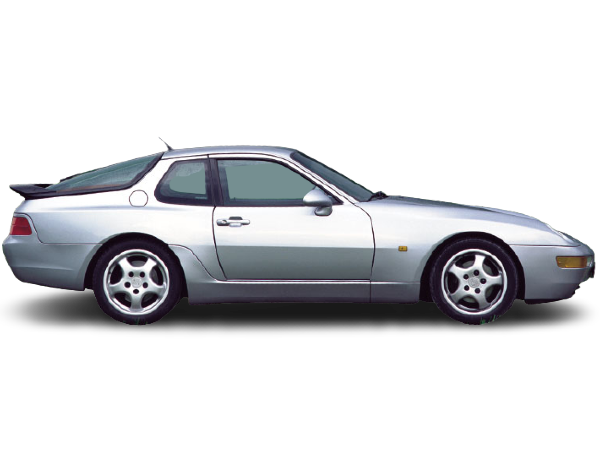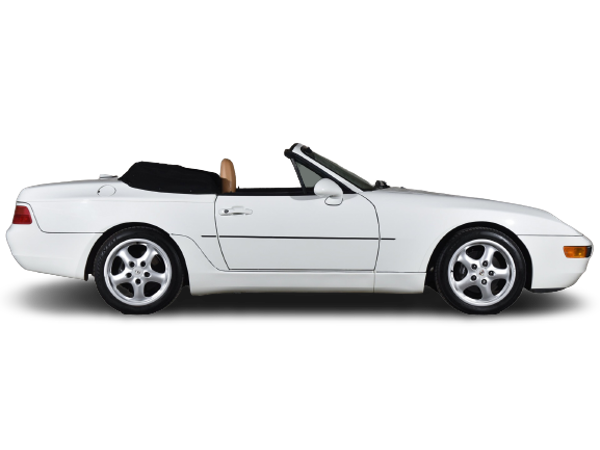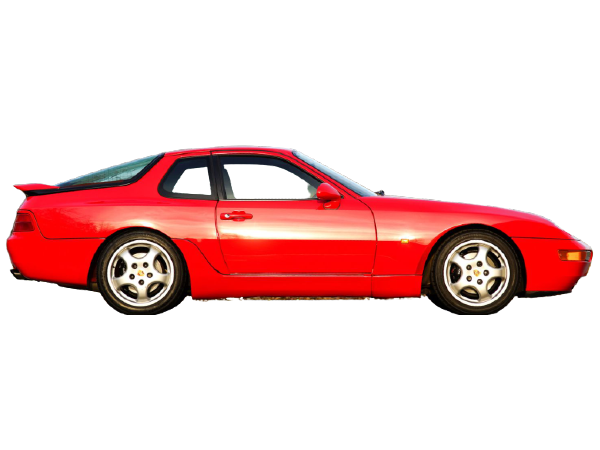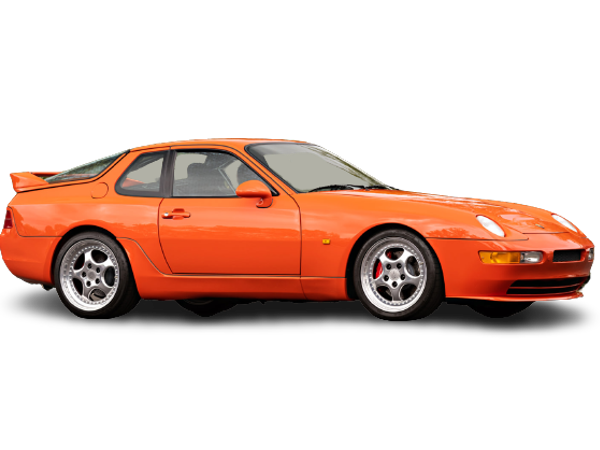The Porsche 968 Story
The Porsche 944 S3
Full Story / Model Guides / Research & Data / Timeline & Evolution / Performance / Videos & Pics / News
The 968 was almost called the 944 "S3", an upgrade to the "968 S2" that Porsche had introduced in 1989. With over 80% of the 944's components new or modified, Porsche decided instead to introduce the car as a new model, hence the 968 was born. Production was moved from the Audi plant in Neckarsulm (where the Porsche 924 and Porsche 944 had been made) to Porsche's own factory in Zuffenhausen. The 968 was produced from 1992 to 1995 and was marketed as the replacement for the Porsche 944. When production ceased in the 1995 model year, it represented the end of a line started almost 20 years earlier with the introduction of the Porsche 924. By late 1991, the 968 was ready. It retained all the good bits of its predecessor, while significantly improving appearance, handling, and performance. The 968 was introduced in September 1991 at the Frankfurt Motor Show as a 1992 model.
The big news new model was the engine. The 968 got an updated version of the 944’s straight-4 engine, now displacing 3.0 L and producing 236 bhp @ 6200 rpm and 225 lb-ft @ 4100 rpm of torque. Changes to the 968's powertrain also included the VarioCam variable valve timing system, a new dual resonant induction, a new exhaust systems with a rare metals catalytic converter, a dual-mass flywheel, and updated engine management electronics. A new 6-speed manual transmission was offered, as well as a dual-mode Tiptronic automatic. The options were plentiful, the most interesting of which was the M030 suspension.
The 968's styling somewhat resembled the 928 although it looks considerably more like a blend of the 993 911, which did not appear until the end of the 968's production and a 944 S2. Like the 944, the 968 was sold as both a coupe and a convertible. Much of the 968's chassis was carried over from the 944S2, which in itself shared many components with the 944 Turbo (internally numbered 951). Borrowed components include the Brembo-sourced 4-piston brake calipers on all four wheels, aluminum semi-trailing arms and aluminum front A-arms, used in a MacPherson strut arrangement. The galvanized steel Unibody structure was also very similar to that of the previous models.
Performance models were also released. A street-legal race variant, dubbed Club Sport, appeared in 1994 with a stripped-out interior including racing seats, revised suspension, and larger wheels and tires, but was offered only in Europe. A UK-only version called 968 Sport, a Club Sport model with some comfort features added back in, was produced in 1994 and 1995. Porsche briefly produced a turbocharged version called Turbo S, of which only 15 were produced, and again was only sold in Europe. The 968 Turbo S was capable of 0–60 mph in 4.5 s and top speed of 175 mph. A race variant called 968 Turbo RS was added as well; only 4 were produced and raced with some success.
Over the 4 years of production, only 12,780 cars were sold worldwide, with less than 5,000 shipped to North America. Original sales price started at about $55,000 and dropped dramatically by the end of production, as lower priced Japanese competition, and the unwillingness of the public to embrace a front engine 4 cylinder Porsche spelled doom for the 968. The 968 was Porsche’s last new front-engined vehicle before the introduction of the Cayenne SUV in 2003. It was sold alongside the 928 GTS through 1995 when both models were dropped.
Manufacturer: Porsche AG / Production Years: 1991 - 1995 / Production: 12,780 units / Designer: Harm Lagaay / Body style: 2-door coupé, 2-door convertible / Layout: Front-engine, rear-wheel-drive / Engines: 3.0 L M44/12 16-valve Inline 4, 3.0 L 8-valve turbocharged Inline 4 / Transmissions: 6-speed manual, 4-speed tiptronic automatic / Dimensions: Wheelbase: 2,400 mm (94.5 in) / Length: 4,320 mm (170.1 in) / Width: 1,735 mm (68.3 in) / Height: 1,275 mm (50.2 in) / Curb weight: 1,400 kg (3,100 lb) / Premiere: September 12, 1991 IAA Frankfurt Motor Show press day
The Porsche 968 was Porsche’s last new front-engined vehicle (of any type) before the introduction of the Porsche Cayenne SUV. Its discontinuation in 1995 coincided with that of the Porsche 928, Porsche’s only other front-engined car at the time.
The Turbo RS was a race car that was made for production when it was homologated as the Porsche 968 Turbo S, a very limited edition car for the road. The Porsche 968 CS Coupe and the UK only 968 Sport were lightweight specials that were definitely the cream of the crop. Below we take a look at the 968 models in detail.
Below we take a look at the performance and specifications for the core production model Porsche 968s.
Free to download Porsche 968 brochures. We have both sales brochures for the 968 as well as parts catalogs. The sales brochures give you a great look into how Porsche positioned the 968 in its sales materials. The parts catalogs are an invaluable tool for finding the information you need for replacements and DIY work.
This graphic breaks out the Porsche 968 in terms of timelines and how to tell all the models apart. Click on the image to see it in higher definition. We have broken out the models by region, model and engine.

The 968 was powered by an updated version of the 944's Inline-four engine, now displacing 3.0 L with a 104 mm bore and a 88 mm stroke and rated at 240 PS (177 kW; 237 hp) at 6,200 rpm and 305 N⋅m (225 lb⋅ft) of torque at 4,100 rpm. Modifications to the engine include a higher 11.0:1 compression ratio, lighter crankshaft, crankcase and pistons along with revised intake valves and intake manifold. Changes to the 968's powertrain also included the addition of Porsche's then-new VarioCam variable valve timing system, newly optimized induction and exhaust systems, a dual-mass flywheel, and updated engine management electronics. For the 1993 model year, the 968 received minor changes, mainly focused on air conditioner and the introduction of special packages and options.
Like its predecessor, the 968 was offered in coupé and convertible bodystyles. All Porsche 968 cabriolets started life as coupes and were converted into cabriolet form by ASC in Heilbronn Germany. Upon conversion they were shipped back to Zuffenhausen for final assembly alongside the 911 and 928. North American spec 968 cabriolets were offered with the full range of Porsche factory-based options as well as the exterior and interior color choices. Unlike ROW (Rest of World) 968s, Cabriolets destined for the US were 2 seaters and outfitted with a double glove box/package tray unit where the rear seats would typically be found.


From 1993 through 1995, Porsche offered a lighter-weight "Club Sport" version of the 968 designed for enthusiasts seeking increased track performance. Much of the 968's luxury-oriented equipment was removed or taken off the options list; less sound deadening material was used, power windows were replaced with crank-driven units, upgraded stereo systems, A/C and sunroof were still optional as on the standard coupé and Convertible models. In addition, Porsche installed manually adjustable lightweight Recaro racing seats, a revised suspension system, 17-inch wheels and wider tires. The four-spoke airbag steering wheel was replaced with a thicker-rimmed three-spoke sports steering wheel with no airbag, heated washer jets were replaced with non heated, vanity covers in the engine bay were deleted, as was the rear wiper. The Club Sport has no rear seats, unlike the 2+2 Coupé.
A UK-only version called "968 Sport", was offered in 1994 and 1995, and was essentially a Club Sport model (and was produced on the same production line with similar chassis numbers) with power windows, electric release boot, central locking, cloth comfort seats (different from both the standard and the Club Sport). With the added electrics the larger wiring loom was used. The Sport Variant also got back the two rear seats, again in the cloth material specific to the Sport. At £29,975, the 968 Sport was priced £5,500 lower than the standard 968, but had most of the latter's desirable "luxuries" and consequently outsold it by a large margin (306 of the 968 Sport models compared to 40 standard 968 coupés).


In 1993, Porsche Motorsports at Weissach briefly produced a turbocharged 968 Turbo S, a fairly odd naming choice for Porsche which usually reserves the added "S" moniker for models that have been tuned for more power over a "lesser" counterpart, such as with the 911 Turbo. The 968 Turbo S shared the same body and interior as the Club Sport and visually can be identified by the NACA bonnet hood scoops, adjustable rear wing, three-piece speedline wheels and deeper front spoiler. The car had the suspension lowered by 17.8 mm (0.7 in) and was 20 kg (45 lb) lighter than the standard 968. The 968 Turbo S was powered by a 3.0 L engine with a 8-valve SOHC cylinder head (from the 944 Turbo S) and 944S2 style engine block. Tests conducted in 1993 returned a 0 to 97 km/h (60 mph) time of 4.7 seconds and a top speed of 282 km/h (175 mph). The engine generated 309 PS (227 kW; 305 hp) at 5,600 rpm with a maximum torque of 500 N⋅m (369 lb⋅ft) at 3,000 rpm. Only 14 were produced in total.
Coupes have a standard ride height, CS and Sport have 20mm shorter front springs and rear torsion bars are 20mm lower.
Coupes has leather seats or sport leather (electrically adjustable). The CS has fibre glass bucket race seats. The 968 Sport has cloth 'comfort' seats.
Coupe has vinyl rear occasional seats. CS has a shelf extending the rear luggage area. Sport has cloth rear occasional seats added back in.
Coupes prior to '93 have 3 spoke steering wheel. Then 4 spoke airbag steering. CS and Sport have the 3 spoke CS steering with thick rim (no airbag).
Coupes have an analogue clock in centre console and a digital temp gauge on dash. CS and Sports have a digital clock on dash with a stopwatch.
Coupes have standard sound proofing, CS and Sports have reduced sound proofing.
Coupes have updated door cards, CS and Sport have the older 944 door cards.
Coupes have the 6 speaker stereo system, CS and Sports have 2 speakers.
Coupes have 16" Cup 1 alloy wheels, CS and Sports have 17" Cup 1 or Cup 2 alloys
Coupes have black plastic vanity covers in the engine bay, CS and Sport don't have these.
Coupes standard battery and wiring loom. CS have a smaller battery, alternator and lighter wiring loom. Sports have standard battery and wiring loom.
Coupes have a rear wiper. Deleted on the CS and Sport and replaced with a watertight cover on the hole in the tailgate glass ('wiper delete bung').
Coupes have heated windscreen washer jets, Club Sports do not.
Coupes have an underbonnet light, Sport and Club Sport do not.
Coupes were available in many different colors, and had options on the interior colors, seats and trim. Club Sports were available in Guards Red, Speed Yellow, Black, White, Maritime Blue and Riviera Blue with or without Club Sport decals down the sides in either black, red or white. Club Sports had colour coded backs to the front seats and a black interior. Sports were available in many different colors, and had black cloth seats and an all black interior.
The Sport (for the UK market only in 1994) was produced on the same production line as the Club Sport so is very similar in the chassis (chassis numbers correspond) and suspension. The key difference between the CS and the Sport is that the Sport has the bigger wiring loom and battery - for the extra electrics that have been put in, electric windows, tailgate release, central locking etc. It also has the occasional rear seats, unlike the CS and it has the comfort front seats. Generally the Sport is a CS with the electrics added in and comfort seats.
Recent auctions, awesome review videos and all the latest news and posts regarding anything to do with the Porsche 968.
Join Our Porsche Community
Sign up for our weekly Porsche newsletter. The latest Porsche news, rumors, reviews and more delivered to your inbox. Cool Porsche stuff perfect for the flat-six obsessed.